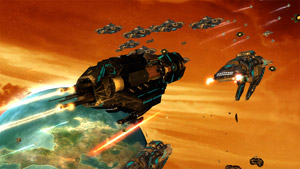Cadenza | Video Games
‘Sins of a Solar Empire: Trinity’ review
eXplore, eXpand, eXploit, eXterminate, eXcept in real time

The strategy game “Sins of a Solar Empire” lets players zoom in on a single ship or zoom out to see entire star systems, each with its own cluster of colonizable planets. (Courtesy Of Stardock Entertainment)
I’m godawful at strategy games. I once lost a game of “Starcraft” to a Korean 4-year-old in a sleazy Web café. True story. Just scrolling through the “Civilization IV” tech tree gave me recurring nightmares of Sid Meier and Julius Caesar holding my girlfriend hostage on Alpha Centauri. Again, totally true. Here’s another story: I’ve spent dozens of hours playing a title that combines both of those games, and my brain has yet to melt. I’ve been treating my inner Admiral Ackbar to “Sins of a Solar Empire,” and given how excellent it is, you should too.
Considering that 4X (explore, expand, exploit and exterminate) games are predominantly turn-based, “Sins” bills itself as the first entry in a new genre—RT4X, which breaks down into Real-Time eXplore, eXpand, eXploit and eXterminate. eXploration involves sending your ships through phase lanes to unknown planets. eXpanding boils down to clearing out a gravity well of hostile ships and capturing a neutral planet with a colony frigate. eXploiting resources means building mineral extractors and burning through research tiers to improve their efficiency. eXterminating opponents should be self-eXplanatory.
The beauty of “Sins” lies in its combination of 4X scale and real-time urgency. There are immense joys to be had from forging a sprawling empire from nearly nothing, all while other players rush to do the same. I begin every match the way all players do, with nothing but a home planet and a frigate factory. Fast-forward two hours. I’ve conquered a dozen worlds, each one’s gravity well dotted with research labs and capital ships alike. Seeing that a pirate raid is imminent, I put a last-minute bounty on the head of a close rival, hoping the pirates will keep him busy while I attack another player. But it pays to be cautious, so I scramble to build defensive structures at my empire’s most prominent choke point (choke planet?), only to find out that I’m out of money.
I begrudgingly ask another player to enter a trade alliance, and luckily he agrees. His cooperation makes me consider sending an envoy ship to his planet to boost our relations to unlock mutually beneficial pacts. Hovering over my credits summary, I see that all of my problems come from my upkeep, which saps over half of my total income to support my two massive fleets. Both are phase jumping to different enemy planets, ready to siege them to hell and back. Some heavy losses later, I’ve finally battered the Vasari Remnant into conceding defeat. It’s time to start thinking about the 50 other planets and four other players in the star system. My empire is on the rise, and I’m hooked on another game of “Sins.”
And unlike most 4X games, “Sins” is actually easy to play because of an absolutely brilliant user interface. Every single button has a helpful tooltip. Almost every ability can be set to auto-cast. Structures are automatically placed and everything can be queued, even ships from a factory still under construction. Then there’s the elegant zoom-to-cursor feature, which eliminates the need to pan the camera across the entire galaxy. Changing planets is a simple matter of zooming out, hovering over a planet, then zooming back in. Ironclad Games deserves nothing short of uber-praise for making a 4X game as complicated as “Sins” so accessible.
For all its playability, however, “Sins” suffers from a lack of depth compared to true 4X and RTS games. In creating a blend of both that doesn’t fry brains, it’s understandable that “Sins” doesn’t have the ludicrous complexities of “Civilization” or the intense micromanagement of “Starcraft.” But there’s more. Despite having a bit of lore and a decent backdrop of galactic warfare, “Sins” doesn’t have a single-player campaign or any semblance of a story. Multiplayer and engaging in a skirmish against computers are the only two options available…Is that—is that sobbing I hear? By God, get a hold of yourself, man. “Sins” is fantastic in skirmish. A single decent-sized game can last almost as long as an entire campaign in another strategy game, and can be just as satisfying. As a rule of thumb, a match with X number of players will take about that many hours to finish. Games can be saved and resumed, naturally. It’s also worth noting that two players can play on a local network with one key.
The original “Sins” was released in early 2008, but since then it has seen two micro-expansions. “Entrenchment” bolsters the game’s defensive options with massive upgradable starbases, and the just-released “Diplomacy” opens up nonviolent options that allow players to ally or backstab their way to victory, as well as a “faster” game speed that puts “fast” to shame. Hot on the heels of the second expansion, publisher Stardock released “Sins of a Solar Empire: Trinity,” which includes the vanilla game and both expansions, priced at an attractive $40. Its release gives me the excuse to write this review two years late. Don’t be late to the party like me, folks—go out and get “Sins of a Solar Empire: Trinity” for some seriously spectacular space strategery.
